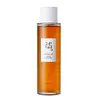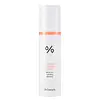What's inside
What's inside
 Key Ingredients
Key Ingredients

 Benefits
Benefits

 Concerns
Concerns

No concerns
 Ingredients Side-by-side
Ingredients Side-by-side

Panax Ginseng Root Water
MaskingButylene Glycol
HumectantGlycerin
HumectantPropanediol
SolventNiacinamide
Smoothing1,2-Hexanediol
Skin ConditioningWater
Skin ConditioningHydroxyacetophenone
AntioxidantGlyceryl Glucoside
HumectantXanthan Gum
EmulsifyingPanthenol
Skin ConditioningDipotassium Glycyrrhizate
HumectantAllantoin
Skin ConditioningAdenosine
Skin ConditioningPanax Ginseng Callus Culture Extract
Skin ConditioningTheobroma Cacao Extract
Skin ConditioningDextrin
AbsorbentGlucose
HumectantPanax Ginseng Root Extract
EmollientPanax Ginseng Berry Extract
Skin ConditioningLactobacillus
Skin ConditioningSodium Hyaluronate
HumectantEthylhexylglycerin
Skin ConditioningDisodium EDTA
Panax Ginseng Root Water, Butylene Glycol, Glycerin, Propanediol, Niacinamide, 1,2-Hexanediol, Water, Hydroxyacetophenone, Glyceryl Glucoside, Xanthan Gum, Panthenol, Dipotassium Glycyrrhizate, Allantoin, Adenosine, Panax Ginseng Callus Culture Extract, Theobroma Cacao Extract, Dextrin, Glucose, Panax Ginseng Root Extract, Panax Ginseng Berry Extract, Lactobacillus, Sodium Hyaluronate, Ethylhexylglycerin, Disodium EDTA
Water
Skin ConditioningBetaine
HumectantGlycerin
HumectantHamamelis Virginiana Bark/Leaf/Twig Extract
Skin ConditioningButylene Glycol
Humectant1,2-Hexanediol
Skin ConditioningCapryloyl Glycine
CleansingHydroxyacetophenone
AntioxidantSodium PCA
HumectantHexylene Glycol
EmulsifyingPEG-40 Hydrogenated Castor Oil
EmulsifyingLactobacillus/Soybean Ferment Extract
Skin ConditioningCandida Bombicola/Glucose/Methyl Rapeseedate Ferment
AntimicrobialDipotassium Glycyrrhizate
HumectantSarcosine
Skin ConditioningDioscorea Japonica Root Extract
Skin ConditioningSodium Hyaluronate
HumectantSaccharomyces Cerevisiae Extract
Skin ConditioningTriticum Vulgare Germ Extract
Skin ConditioningAllantoin
Skin ConditioningPEG-60 Almond Glycerides
EmulsifyingTremella Fuciformis Extract
HumectantCaprylyl Glycol
EmollientCinnamomum Zeylanicum Bark Extract
AntimicrobialEthylhexylglycerin
Skin ConditioningParfum
MaskingCarbomer
Emulsion StabilisingDisodium EDTA
Phellinus Linteus Extract
Skin ConditioningCordyceps Sinensis Extract
AntioxidantGanoderma Lucidum Extract
Skin ProtectingNordihydroguaiaretic Acid
AntioxidantOleanolic Acid
Skin ConditioningWater, Betaine, Glycerin, Hamamelis Virginiana Bark/Leaf/Twig Extract, Butylene Glycol, 1,2-Hexanediol, Capryloyl Glycine, Hydroxyacetophenone, Sodium PCA, Hexylene Glycol, PEG-40 Hydrogenated Castor Oil, Lactobacillus/Soybean Ferment Extract, Candida Bombicola/Glucose/Methyl Rapeseedate Ferment, Dipotassium Glycyrrhizate, Sarcosine, Dioscorea Japonica Root Extract, Sodium Hyaluronate, Saccharomyces Cerevisiae Extract, Triticum Vulgare Germ Extract, Allantoin, PEG-60 Almond Glycerides, Tremella Fuciformis Extract, Caprylyl Glycol, Cinnamomum Zeylanicum Bark Extract, Ethylhexylglycerin, Parfum, Carbomer, Disodium EDTA, Phellinus Linteus Extract, Cordyceps Sinensis Extract, Ganoderma Lucidum Extract, Nordihydroguaiaretic Acid, Oleanolic Acid
 Reviews
Reviews

Ingredients Explained
These ingredients are found in both products.
Ingredients higher up in an ingredient list are typically present in a larger amount.
1,2-Hexanediol is a synthetic liquid and another multi-functional powerhouse.
It is a:
- Humectant, drawing moisture into the skin
- Emollient, helping to soften skin
- Solvent, dispersing and stabilizing formulas
- Preservative booster, enhancing the antimicrobial activity of other preservatives
Allantoin is a soothing ingredient known for its protective and moisturizingg properties. Because of this, it is often added to products with strong active ingredients.
Studies show higher concentrations of this ingredient can promote wound healing.
Though it can be derived from the comfrey plant, allantoin is produced synthetically for cosmetic products to ensure purity.
Learn more about AllantoinButylene Glycol (or BG) is used within cosmetic products for a few different reasons:
Overall, Butylene Glycol is a safe and well-rounded ingredient that works well with other ingredients.
Though this ingredient works well with most skin types, some people with sensitive skin may experience a reaction such as allergic rashes, closed comedones, or itchiness.
Learn more about Butylene GlycolDipotassium Glycyrrhizate comes from licorice root.
Extracts of licorice have demonstrated to have antibacterial, anti‐inflammatory, antiviral, antioxidant properties.
One component, glabridin, has extra potent antioxidant and soothing properties. It has also been found to block pigmentation from UVB rays in guinea pigs.
Licorice Root also contains a flavonoid. Flavonoids are a natural substance from in plants. Flavonoids also have antioxidant properties.
Another component, glycyrrhizin, has been found to have anti-inflammatory and antimicrobial benefits. This may make licorice root extract effective at treating acne. However, more research is needed to support this.
Liquiritin is one of the flavone compounds found in licorice. It has been found to help lighten skin by preventing tyrosinase from reacting with tyrosine. When the two react, protein is converted to melanin. Melanin is the substance in your body that gives your features pigmentation.
Licorice root is native to Southern Europe and Asia. It has been used in traditional Chinese medicine to help with respiratory issues.
Learn more about Dipotassium GlycyrrhizateDisodium EDTA plays a role in making products more stable by aiding other preservatives.
It is a chelating agent, meaning it neutralizes metal ions that may be found in a product.
Disodium EDTA is a salt of edetic acid and is found to be safe in cosmetic ingredients.
Learn more about Disodium EDTAEthylhexylglycerin (we can't pronounce this either) is commonly used as a preservative and skin softener. It is derived from glyceryl.
You might see Ethylhexylglycerin often paired with other preservatives such as phenoxyethanol. Ethylhexylglycerin has been found to increase the effectiveness of these other preservatives.
Glycerin is already naturally found in your skin. It helps moisturize and protect your skin.
A study from 2016 found glycerin to be more effective as a humectant than AHAs and hyaluronic acid.
As a humectant, it helps the skin stay hydrated by pulling moisture to your skin. The low molecular weight of glycerin allows it to pull moisture into the deeper layers of your skin.
Hydrated skin improves your skin barrier; Your skin barrier helps protect against irritants and bacteria.
Glycerin has also been found to have antimicrobial and antiviral properties. Due to these properties, glycerin is often used in wound and burn treatments.
In cosmetics, glycerin is usually derived from plants such as soybean or palm. However, it can also be sourced from animals, such as tallow or animal fat.
This ingredient is organic, colorless, odorless, and non-toxic.
Glycerin is the name for this ingredient in American English. British English uses Glycerol/Glycerine.
Learn more about GlycerinHydroxyacetophenone is antioxidant with skin conditioning and soothing properties. It also boosts the efficiency of preservatives.
This ingredient is not irritating or sensitizing.
Sodium Hyaluronate is hyaluronic acid's salt form. It is commonly derived from the sodium salt of hyaluronic acid.
Like hyaluronic acid, it is great at holding water and acts as a humectant. This makes it a great skin hydrating ingredient.
Sodium Hyaluronate is naturally occurring in our bodies and is mostly found in eye fluid and joints.
These are some other common types of Hyaluronic Acid:
Learn more about Sodium HyaluronateWater. It's the most common cosmetic ingredient of all. You'll usually see it at the top of ingredient lists, meaning that it makes up the largest part of the product.
So why is it so popular? Water most often acts as a solvent - this means that it helps dissolve other ingredients into the formulation.
You'll also recognize water as that liquid we all need to stay alive. If you see this, drink a glass of water. Stay hydrated!
Learn more about Water